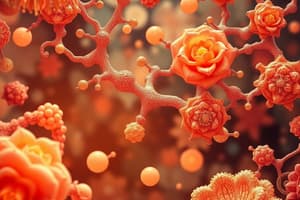Podcast
Questions and Answers
What is the primary function of enzymes in a chemical reaction?
What is the primary function of enzymes in a chemical reaction?
- Increase the free energy of reactants
- Convert substrates into products irreversibly
- Change the equilibrium position of the reaction
- Lower the energy barrier for the reaction (correct)
Which model of enzyme activity suggests that the active site undergoes a conformational change to fit the substrate?
Which model of enzyme activity suggests that the active site undergoes a conformational change to fit the substrate?
- Lock and key model
- Static model
- Dynamic model
- Induced fit model (correct)
What aspect of the active site promotes high-affinity binding of a substrate?
What aspect of the active site promotes high-affinity binding of a substrate?
- Exclusion of all cofactors
- Size and shape of the active site (correct)
- Temperature of the reaction environment
- Presence of only non-polar amino acids
How do enzymes lower the activation energy of a reaction?
How do enzymes lower the activation energy of a reaction?
What does the term 'proximity effect' refer to in enzyme catalysis?
What does the term 'proximity effect' refer to in enzyme catalysis?
Which statement about enzymes is NOT true?
Which statement about enzymes is NOT true?
What type of groups do enzymes provide that are critical for catalysis?
What type of groups do enzymes provide that are critical for catalysis?
Which of the following is NOT a property of the active site in enzymes?
Which of the following is NOT a property of the active site in enzymes?
What role do isoenzymes play in response to cell signals?
What role do isoenzymes play in response to cell signals?
Which of the following is NOT a characteristic of all enzymes?
Which of the following is NOT a characteristic of all enzymes?
What makes the CK2-MB isoenzyme useful as a diagnostic marker?
What makes the CK2-MB isoenzyme useful as a diagnostic marker?
What is the primary function of the active site of an enzyme?
What is the primary function of the active site of an enzyme?
Ribozymes are unique because they are composed primarily of which type of molecule?
Ribozymes are unique because they are composed primarily of which type of molecule?
Which of the following correctly describes the formation of an enzyme-substrate complex?
Which of the following correctly describes the formation of an enzyme-substrate complex?
Which cofactor is typically associated with oxidative reactions?
Which cofactor is typically associated with oxidative reactions?
What happens after the enzyme-substrate complex (ES) forms in the catalytic cycle?
What happens after the enzyme-substrate complex (ES) forms in the catalytic cycle?
What is one of the key components of the serine protease mechanism of catalysis?
What is one of the key components of the serine protease mechanism of catalysis?
Which amino acids are primarily involved in the catalytic triad of serine proteases?
Which amino acids are primarily involved in the catalytic triad of serine proteases?
Which factor does NOT affect enzyme catalytic activity?
Which factor does NOT affect enzyme catalytic activity?
What effect does increasing temperature generally have on reaction rates?
What effect does increasing temperature generally have on reaction rates?
Which statement best describes the relationship between pH and enzyme activity?
Which statement best describes the relationship between pH and enzyme activity?
What happens to the active site of an enzyme when the temperature is too high?
What happens to the active site of an enzyme when the temperature is too high?
What describes the effect of substrate concentration on the reaction rate of enzymes?
What describes the effect of substrate concentration on the reaction rate of enzymes?
Which of the following is a consequence of pH affecting enzymatic activity?
Which of the following is a consequence of pH affecting enzymatic activity?
Why is it essential for serine proteases to maintain a specific structural configuration?
Why is it essential for serine proteases to maintain a specific structural configuration?
What is a characteristic of the optimum pH for an enzyme's activity?
What is a characteristic of the optimum pH for an enzyme's activity?
What role do enzymes play in biochemical reactions?
What role do enzymes play in biochemical reactions?
What is the impact of enzymes on reaction rates?
What is the impact of enzymes on reaction rates?
Which statement about enzyme consumption in reactions is true?
Which statement about enzyme consumption in reactions is true?
What are cofactors in relation to enzymes?
What are cofactors in relation to enzymes?
What happens to enzyme activity when its structure is denatured?
What happens to enzyme activity when its structure is denatured?
Which of the following statements about enzyme localization is accurate?
Which of the following statements about enzyme localization is accurate?
How do cofactors influence enzyme functions besides catalysis?
How do cofactors influence enzyme functions besides catalysis?
What is the difference between an apoenzyme and a holoenzyme?
What is the difference between an apoenzyme and a holoenzyme?
What does one International Unit (IU) of an enzyme represent?
What does one International Unit (IU) of an enzyme represent?
How is specific activity defined?
How is specific activity defined?
What happens to specific activity after purification of an enzyme?
What happens to specific activity after purification of an enzyme?
How is enzyme activity affected by changes in environmental conditions?
How is enzyme activity affected by changes in environmental conditions?
Why might a low activity enzyme require more total amount for the same reaction rate as a high activity enzyme?
Why might a low activity enzyme require more total amount for the same reaction rate as a high activity enzyme?
What is an isoenzyme?
What is an isoenzyme?
Which of the following statements is true regarding the relationship between total amount of enzyme and specific activity?
Which of the following statements is true regarding the relationship between total amount of enzyme and specific activity?
In order to express enzyme activity, which of the following is crucial to denote?
In order to express enzyme activity, which of the following is crucial to denote?
Flashcards are hidden until you start studying
Study Notes
Enzymes
- Proteins that act as biological catalysts.
- Accelerate reaction rates for up to 10^14 to 10^16 times.
- Reduce or prevent generation of unwanted by-products.
- Work in an organized sequence to produce specific products.
- Not consumed during the reaction.
- Cannot change the free energy of a reaction.
Enzyme Properties
- Molecular weight ranges from 12,000 to over 1 million Da.
- Requires native protein conformation for catalytic activity.
- Localization is important, with enzymes within the same pathways often compartmentalized together.
- Compartmentalized to prevent unwanted activity.
Cofactors
- Additional components required for catalytic activity.
- Include inorganic ions, coenzymes, and organometallic groups.
- Apoenzyme + cofactor = holoenzyme.
- Assist in reactions by forming covalent interactions with substrate.
- Oxidation-reduction with unique functional groups that accept or donate electrons.
- Can influence enzyme tertiary structure.
Measuring Enzyme Activity
- One International Unit (IU):
- The amount of enzyme that catalyzes the formation of one micromole of product in one minute (1 U = μmol/min).
- Conditions of the assay must be specified because enzymes are sensitive to pH, temperature, and ionic strength.
- Specific activity:
- Units of enzyme activity per milligram of protein in a sample.
- A measure of enzyme purity.
Isoenzymes
- Different forms of an enzyme that catalyze the same chemical reaction.
- May vary in:
- Sub-cellular location.
- Tissue distribution.
- Kinetic properties (affinity for substrates and inhibitors, regulatory properties, and cofactors used).
- Can be useful diagnostic markers for tissue damage.
Creative Kinase (CK) Isoenzymes
- Found in different tissues:
- CK1 – BB (brain).
- CK2 – MB: (cardiac).
- CK3 – MM: (muscle).
- Measured in blood to diagnose tissue damage
- Elevated CK2-MB levels suggest heart damage.
- Skeletal muscle and brain have different isoforms.
Studying That Suits You
Use AI to generate personalized quizzes and flashcards to suit your learning preferences.




